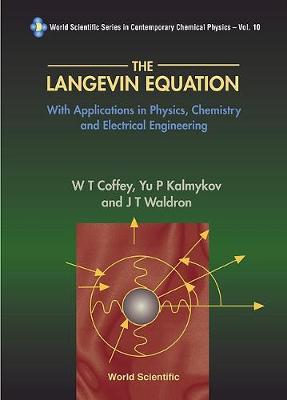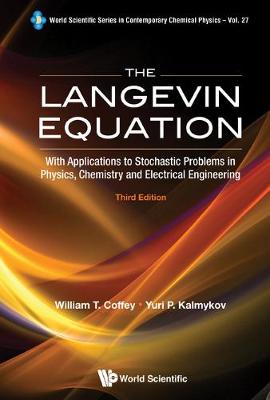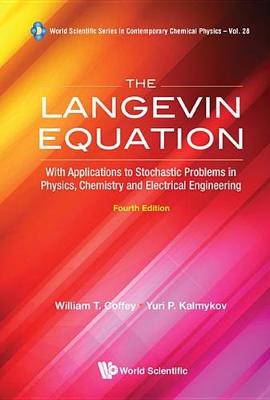World Scientific Series In Contemporary Chemical Physics
4 primary works • 6 total works
Book 10
Langevin Equation, The: With Applications In Physics, Chemistry And Electrical Engineering
by William T Coffey, Yuri P Kalmykov, and John T Waldron
Published 3 July 1996
The book is suitable for a lecture course on the theory of Brownian motion, being based on final year undergraduate lectures given at Trinity College, Dublin. Topics that are discussed include: white noise; the Chapman-Kolmogorov equation — Kramers-Moyal expansion; the Langevin equation; the Fokker-Planck equation; Brownian motion of a free particle; spectral density and the Wiener-Khintchin theorem — Brownian motion in a potential application to the Josephson effect, ring laser gyro; Brownian motion in two dimensions; harmonic oscillators; itinerant oscillators; linear response theory; rotational Brownian motion; application to loss processes in dielectric and ferrofluids; superparamagnetism and nonlinear relaxation processes.As the first elementary book on the Langevin equation approach to Brownian motion, this volume attempts to fill in all the missing details which students find particularly hard to comprehend from the fundamental papers contained in the Dover reprint — Selected Papers on Noise and Stochastic Processes, ed. N Wax (1954) — together with modern applications particularly to relaxation in ferrofluids and polar dielectrics.
Book 14
This volume is the second edition of the first-ever elementary book on the Langevin equation method for the solution of problems involving the Brownian motion in a potential, with emphasis on modern applications in the natural sciences, electrical engineering and so on. It has been substantially enlarged to cover in a succinct manner a number of new topics, such as anomalous diffusion, continuous time random walks, stochastic resonance etc, which are of major current interest in view of the large number of disparate physical systems exhibiting these phenomena. The book has been written in such a way that all the material should be accessible to an advanced undergraduate or beginning graduate student. It draws together, in a coherent fashion, a variety of results which have hitherto been available only in the form of research papers or scattered review articles.
Book 27
This volume is the third edition of the first-ever elementary book on the Langevin equation method for the solution of problems involving the translational and rotational Brownian motion of particles and spins in a potential highlighting modern applications in physics, chemistry, electrical engineering, and so on. In order to improve the presentation, to accommodate all the new developments, and to appeal to the specialized interests of the various communities involved, the book has been extensively rewritten and a very large amount of new material has been added. This has been done in order to present a comprehensive overview of the subject emphasizing via a synergetic approach that seemingly unrelated physical problems involving random noise may be described using virtually identical mathematical methods in the spirit of the founders of the subject, viz., Einstein, Langevin, Smoluchowski, Kramers, etc. The book has been written in such a way that all the material should be accessible both to an advanced researcher and a beginning graduate student. It draws together, in a coherent fashion, a variety of results which have hitherto been available only in the form of scattered research papers and review articles.
Book 28
Our original objective in writing this book was to demonstrate how the concept of the equation of motion of a Brownian particle — the Langevin equation or Newtonian-like evolution equation of the random phase space variables describing the motion — first formulated by Langevin in 1908 — so making him inter alia the founder of the subject of stochastic differential equations, may be extended to solve the nonlinear problems arising from the Brownian motion in a potential. Such problems appear under various guises in many diverse applications in physics, chemistry, biology, electrical engineering, etc. However, they have been invariably treated (following the original approach of Einstein and Smoluchowski) via the Fokker-Planck equation for the evolution of the probability density function in phase space. Thus the more simple direct dynamical approach of Langevin which we use and extend here, has been virtually ignored as far as the Brownian motion in a potential is concerned. In addition two other considerations have driven us to write this new edition of The Langevin Equation. First, more than five years have elapsed since the publication of the third edition and following many suggestions and comments of our colleagues and other interested readers, it became increasingly evident to us that the book should be revised in order to give a better presentation of the contents. In particular, several chapters appearing in the third edition have been rewritten so as to provide a more direct appeal to the particular community involved and at the same time to emphasize via a synergetic approach how seemingly unrelated physical problems all involving random noise may be described using virtually identical mathematical methods. Secondly, in that period many new and exciting developments have occurred in the application of the Langevin equation to Brownian motion. Consequently, in order to accommodate all these, a very large amount of new material has been added so as to present a comprehensive overview of the subject.





